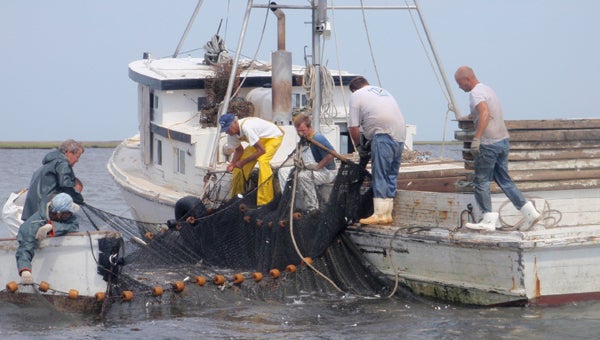Outdoors: Sharks and stingrays in the Pamlico?
Published 8:17 pm Thursday, July 9, 2015
 All this news about shark attacks along our southern North Carolina beaches made me immediately think about an incident that happened when our daughter and I were surf fishing in Drum Inlet off Portsmouth Island. It was late in the day and the tide was running out pretty strong into a relatively calm ocean. Lots of baitfish were in the area and we were casting our lines baited with cut mullet out into the main stream of the outgoing tide.
All this news about shark attacks along our southern North Carolina beaches made me immediately think about an incident that happened when our daughter and I were surf fishing in Drum Inlet off Portsmouth Island. It was late in the day and the tide was running out pretty strong into a relatively calm ocean. Lots of baitfish were in the area and we were casting our lines baited with cut mullet out into the main stream of the outgoing tide.
When Jenny started getting a little too deep to suit me, I yelled at her to be careful because the water was running out the inlet at a good clip. Seconds later, she screamed and began frantically running (as well as she could in water waist deep) toward shore. When she was close to me, I saw that her normally suntanned face was nearly white. Dad, she gasped to me, something really big just brushed up against me out there. It worried both of us for a while, but we continued to fish until dark and then returned to our cabin.
After supper, we tuned in to a radio station in the Norfolk area and heard about a SCUBA diver who’d been attacked and killed by a large shark off the Virginia coast. It was then that we really became worried and, at the same time, thankful that whatever kind of “big thing” it was that had brushed up against her in Drum Inlet had left her unharmed.
I’m sure that a lot of families are headed for our coast this holiday weekend and I’m sure they all feel apprehensive about the recent shark attacks off our coast. They should be concerned and take the necessary precautions when swimming in our ocean waters. Every publication you see for the past few weeks has been filled with very good advice on swimming in waters where sharks are known to be. We have to face it; there is a chance that we may encounter sharks in all of our coastal waters. Not just the ocean, but the sounds and rivers as well. These waters include the purely fresh waters that feed into the ocean waters.
The only well-documented shark attack I know of that has ever occurred in the more inland waters happened on Pamlico Sound about 30 years ago. A family was taking their 32-foot sailboat from Oriental to Ocracoke. It was a sunny beautiful day with a good wind for their trip. The daughter, a student at N.C. State, decided to take a leisurely ride on an inner tube that was being pulled behind the sailboat.
Somewhere off the eastern tip of the Brant Island Shoal, the young woman was holding onto the inner tube with most of her upper body on the tube and her lower body trailing easily off the back of the tube. The shark, later identified from the extensive tooth marks on the girls lower torso, as a bull shark, made its attack very quickly and the girl managed to hold onto the tube until her family pulled her into the boat.
Emergency first aid was applied in the boat and a frantic call to the U.S. Coast Guard brought in a helicopter that flew the girl to the hospital in Morehead. The injuries were very extensive, but the doctors repaired the damage and, after months of recuperation, the young woman survived.
The only large shark I’ve ever actually seen in Pamlico Sound was behind Cedar Island. Two large commercial fishing boats were going about setting out a huge “long-haul net” in one of the unusually deep (maybe 9-feet deep) sections of the sound. The two boats gradually played out the net off their sterns as they went in opposite directions, circled around and completed the net-set with the estimated net length of one mile. With the aid of several smaller boats and the two large boats, the encircled area was then gradually decreased until the encircled area was maybe 35 feet across. The area inside this now-small opening held a huge mass of struggling fish of every imaginable kind.
Into this struggling mass of finfish, skates and sting rays, a couple of adventuresome commercial fishermen jumped and commenced to aid the fishermen on the larger boats for their marketable catch. I guided our small boat in for a photo-op and looked down in in time to see this mass of fish and humans. There was one shark that I estimated to be 12 feet long in the catch. Into this mass of estuarine life the fishermen who’d jumped in showed no fear as they bailed the edible fish up to the waiting large boats.
After separating the food fish from the shark, rays skates and other estuarine life that had been caught in the long-haul net, the commercial fishermen had perhaps three tons of finfish to take to market that day. The remaining fish were released unharmed. The fishermen who’d joined the assortment of fish in the net were also unharmed.
One of the favorite foods of sharks are rays and our Albemarle-Pamlico estuaries are filled with huge numbers of cownose rays these days. The rays feed largely on shellfish such as clams, scallops, oysters and crabs and some blame the abundance of cownose rays on the shortage of shellfish. The rays are despised by both sport and commercial fishermen, who probably do their best to be sure that the rays they release after being hooked or netted aren’t in very good shape. It’s only natural that if there are any sharks in the area that they’d find easy pickings with the wounded rays.
If swimmers are to be in our coastal waters, it would be a good idea to take heed of the following tips that the Daily News recently suggested. “Always swim in a group, don’t wander too far from shore, avoid the water at specific times (night dusk, or dawn), don’t enter the water if bleeding, don’t wear shiny jewelry, avoid waters being fished and those with lots of bait fish in them and don’t enter waters where sharks are swimming.”





